Ready to pedal your way toward serious weight loss? Here is how to use a stationary bike for losing weight, including my favorite pro tips and some sample workouts to get you started.
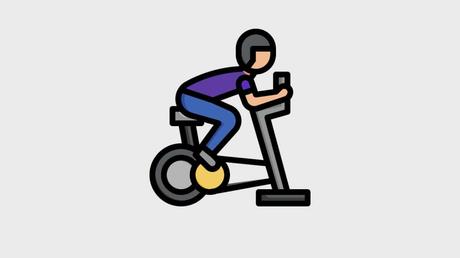
- Why the Stationary Bike Rocks for Losing Weight
- Stationary Bike Workouts for Weight Loss
- Tips for Maximizing Weight Loss on the Stationary Bike
Few cardio machines can hold a candle to a stationary bike when it comes to losing weight.
It’s not just one of the best cardio machines for burning calories, but as you’ll see below, it offers heaps of other benefits that make it an excellent choice for both newbies and advanced trainees.
In this post, I’ll highlight some of the top benefits of the stationary bike, share with you some of my favorite fat-blasting stationary bike workouts, and give you some simple but highly practical tips for seeing real weight loss using this machine.
Whether you are a beginner or a more experienced trainee looking to fine-tune your weight loss workouts for that last little bit of weight loss, this guide has you covered.
Let’s jump right in…
Why the Stationary Bike Rocks for Losing Weight
 Excellent Calorie-Burning
Excellent Calorie-Burning

There is no way to say definitively that there is one single best cardio machine for losing weight.
Really, any machine that you can use regularly and work hard on is a good option. And choosing the perfect cardio machine ultimately comes down to your specific needs and abilities.
But I will say that there’s a good reason stationary bikes are among the most popular cardio machines on the planet.
When it comes to how many calories the stationary bike burns, it’s an absolute contender.
According to Harvard Medical School1:
- A 125-pound athlete can burn 210 calories over in just 30 minutes of a “moderate” stationary bike workout.
- A 155-pound athlete can burn 252 calories over in just 30 minutes of a “moderate” stationary bike workout.
- A 125-pound athlete can burn 294 calories over in just 30 minutes of a “moderate” stationary bike workout.
Based on this data, the stationary bike is roughly comparable to pretty much any high-impact aerobics and rowing workout, even a moderate-paced run (5 MPH) or fast walk/jog.
But if you push the pace a bit, you’ll find the stationary bike becomes a true calorie-burning superstar.
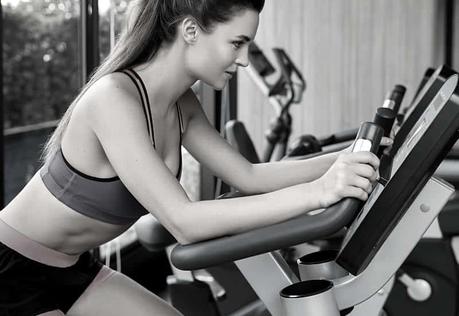
From that same Harvard Medical School data:
- A 125-pound athlete can burn 315 calories over in just 30 minutes of a “vigorous” stationary bike workout.
- A 155-pound athlete can burn 378 calories over in just 30 minutes of a “vigorous” stationary bike workout.
- A 125-pound athlete can burn 441 calories over in just 30 minutes of a “vigorous” stationary bike workout.
Based on this data, the stationary bike is roughly comparable to an elliptical machine, running at a faster pace (6 MPH), or even doing martial arts (like kickboxing or karate).
 Joint-Friendly
Joint-Friendly

One of the greatest benefits of stationary bikes is that they are low-impact.
With high-impact exercise, like running or even jumping rope, each time the foot strikes the ground, vibrations travel up your skeletal system. Over time, with repeated impacts, and with more impact, the joints accumulate swelling, stiffness, and soreness. That’s why your body feels achier and stiffer after a sprint vs. a slow walk.
A stationary bike almost entirely eliminates the blunt force trauma on your joints while retaining all of the good stuff, like improved cardiovascular health, improved fitness, and a smaller number on the weight scale.
 Great for Fat-Burning
Great for Fat-Burning

One area where the stationary bike excels is in the realm of fat-burning.
When you exercise at maximum intensity (for example, a sprint or lifting weights), your body is only able to use the glucose-based energy in your bloodstream. However, when you lift at a lower intensity (such as a jog or cycling workout), your body can absorb enough oxygen to activate and utilize its stored fats.
What this means is that though high-intensity exercise burns more energy overall, lower-intensity exercise is better for fat-burning.
The key to seeing real results is to combine both types of exercise into one—and that’s where cycling is a great option (i.e. interval training).
Put this all together, and you’ll burn lots of calories, but still ensure your body is absorbing enough oxygen to utilize stored fats for energy rather than just burning through your glucose-based energy.
 Better Lower Body Strength
Better Lower Body Strength

We’ve talked a lot about cardio and calories, but the muscular strength and endurance you’ll develop through your stationary bike training is important, too.
Cycling uses only your legs: your glutes, hamstrings, quads, calves, and shin muscles.
When sitting down, your quads do the majority of the work, with some support from your hamstrings and glutes. When standing up, your hamstrings and glutes engage in greater measure, as do your calves.
Combining these two movements will ensure all of your leg muscles get a better workout. No matter what type of stationary bike you use, you can trust the outcome will be the same: a fitter cardiovascular system as well as stronger legs.
Stationary Bike Workouts for Weight Loss
Time to get down to brass tacks and get some real work in!
I want to share with you my four favorite stationary bike workouts: one for first-timers, one for fat-burning, one for endurance, and one to knock out on those days when you’ve only got a few minutes to spare.
Each of these workouts has something to offer and will impact your body in different ways. Give them all a try and see which suits you best.
A Quick Note on RPE:
Below, we will be talking about Rate of Perceived Exertion, or RPE. This refers to how difficult a workout feels for you.
You can use other metrics—such as RPM or MPH—but RPE is the easiest one to use and will work with any type of stationary bike or air bike that doesn’t include a full suite of metrics displayed on a digital screen.
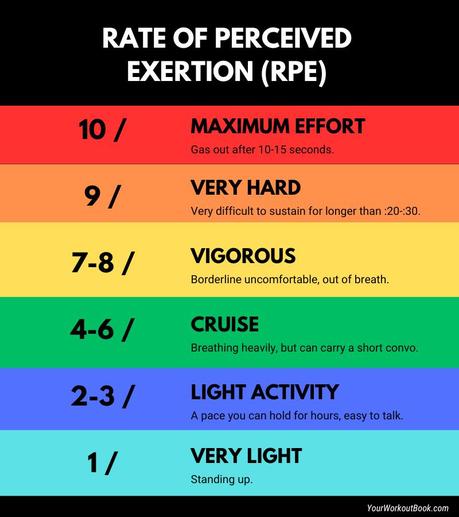
Alrighty, let’s get into the workouts!
Workout #1: Newbie Cycling Training
If this is your first time ever sitting on a stationary bike, don’t worry, we’ll take it easy on you. At first.
A slow start will give your body time to get accustomed to the workout, and as you adapt, you can ramp up your efforts and feel the burn!
The Workout:
- Start off with 5 minutes of stretching to limber up your muscles, loosen stiff joints, and get your body ready to work. Follow it up with 5 minutes of cycling at a light pace—around 2 to 3 RPE, or light enough you are barely breathing hard.
- Begin your workout with 5 minutes of cycling at around 4 RPE. You shouldn’t be working too hard, just enough that you’ll feel yourself beginning to sweat, your body heat up, and your breathing come a little faster.
- Add some resistance to make the workout a bit harder. Don’t pick up the pace, though. This minor adjustment will raise your RPE to around 5 or 6. Keep cycling for another 5 minutes.
- Lower the resistance, but raise your speed. This will maintain your RPE in the 5 to 6 range. Keep this going for 5 minutes.
- Add in some hill sprints. Raise the resistance to 75% max, and keep it there for 30 to 60 seconds to simulate climbing a hill. Then lower the resistance for 90 seconds to give yourself a chance to recover. Repeat this cycle 8 times, for a total of 10 minutes.
- Bring in some cycling sprints. Lower the resistance to around 10 to 20%, and pedal as fast as you can for 30 seconds. Recover for 90 seconds before the next 30-second sprint. Repeat this cycle 5 times, for a total of 10 minutes.
- Cool down with 5 minutes of cycling at 2 to 3 RPE and finish off with 5 minutes of stretching. Congratulations on knocking out a heck of a first workout!
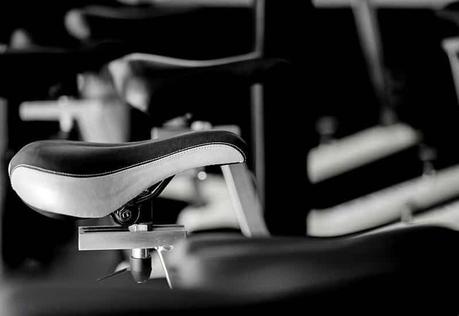
Workout #2: Fat Blaster
With this workout, the goal is to burn as much fat as possible. That means working hard enough that you torch calories, but not so hard your body is forced to burn only glucose-based energy.
To activate and utilize stored fats, you’ve got to work in a lower RPE range but maintain the pace for longer.
The Workout:
- Warm up with 5 minutes of stretching followed by 5 minutes of cycling at 2 to 3 RPE.
- Raise the resistance to 10 to 20%, and increase your cycling speed slightly. Your goal should be to reach the 5 to 7 RPE range.
- Maintain this 5 to 7 RPE for 45 minutes.
- Bonus: If you really want to add some challenge, try pedaling standing up for 60 seconds every 5 minutes.
- Cool down with 5 minutes of cycling at 2 to 3 RPE and finish off with 5 minutes of stretching.
Workout #3: Pyramid Endurance Training
Pyramid training is amazing for endurance!
It will force your body to gradually utilize more and more energy until you reach your “max”, then maintain that max output for longer until you gradually return to your starting point. Done right, it’s a game-changer for improving your fitness.
The Workout:
- Warm up with 5 minutes of stretching followed by 5 minutes of cycling at 2 to 3 RPE.
- Minute 1: Raise the resistance by 1 level (out of 10) to make the pedaling harder.
- Minute 2: Pedal standing up.
- Minute 3: Pedal slightly faster (+1 or 2 RPM, or +0.2 MPH)
- Repeat this three-minute cycle, raising the resistance by 1 level, pedaling standing up, and increasing your speed.
- Work until you are at an RPE of 8 or 9. Then start lowering the resistance and speed until you’re back at your starting point.
- Cool down with 5 minutes of cycling at 2 to 3 RPE and finish off with 5 minutes of stretching.
Workout #4: HIIT It and Quit It
If you’ve only got a few minutes to fit in a workout, HIIT (high intensity interval training) will be your best friend.
Twenty minutes of training time and you’ll burn some serious calories!
The Workout:
- Warm up with 5 minutes of stretching followed by 5 minutes of cycling at 2 to 3 RPE.
- Cycle as fast as you can for 45 seconds.
- Cycle at a slower “recovery” pace for 75 seconds.
- Repeat this 10 times, for a total of 20 minutes.
- Cool down with 5 minutes of cycling at 2 to 3 RPE and finish off with 5 minutes of stretching.
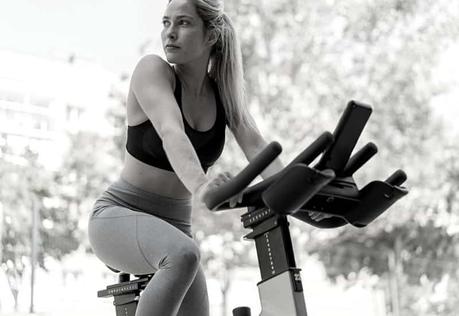
Tips for Maximizing Weight Loss on the Stationary Bike
The time you spend on the stationary bike (and all cardio machines) is intended to help you burn more calories and lose more weight.
Here are some tips that will help you to do exactly that:
- Add more hills. Hills are more demanding on your muscles, which require more energy to power, meaning more calories burned. Plus, you’ll develop greater muscular endurance alongside your cardiovascular endurance.
- Increase your speed. Even if you can’t maintain a very fast cycling pace for the entire workout, it’s worth increasing your speed periodically in order to push your body to work harder and burn more energy. Over the course of a few weeks, you’ll notice that your “average” or “baseline” speed will increase, as will the total energy expended as your body adapts to the faster pace.
- Stand up. Pedaling standing up is hard work on your legs, so your body has to activate more stored energy in order to power them.
- Try HIIT. The periods of maximum intensity will burn through a lot of calories, but the periods of low intensity will enable your body to burn fat, too, as well as facilitate recovery. HIIT is one of the most effective fat-burning, weight-loss-friendly workouts on the planet.
- Be consistent. Put in the time every week, incorporating at least 3 to 4 stationary bike workouts into your training regimen. Consistency is the key to results!
The Bottom Line
You’ve seen what sort of benefits a stationary bike can offer, and you’ve learned some simple yet highly effective workouts to try, even a few tips to maximize your weight loss.
All that’s left now is to take everything you’ve seen in this article and put it into practice on your stationary bike.
Good luck, and happy training!
